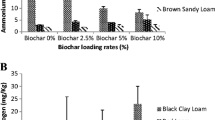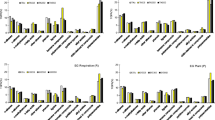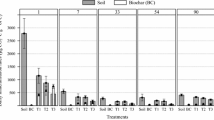Abstract
Purpose
The recent literature indicates that, depending on the feedstocks and pyrolysis temperature, biochar can be a good source of nutrients. On the contrary, some biochars are not good sources of available carbon and other nutrients, but their porous structure seems to be a suitable microenvironment for microbial colonization. We investigated the response of soil biological parameters, microbial biomass carbon and nitrogen (MBC and MBN), in relation to mobile N species.
Material and methods
Five different biochars were produced at different temperatures (300, 350, 400, 450, and 500 °C) from the same feedstock (woodchips). The physicochemical and morphological characteristics of the individual biochar samples were described, and incubation was carried out with the application of 2% biochar to two different soil types (luvisol and fluvisol).
Results and discussion
The addition of 2% biochar did not change the pH in the slightly acid soils used in the experiment, in spite of the alkaline character of biochar. The increasing amounts of total and nitrate-available nitrogen during the experiment are probably related to changes in soil microbial activity. The amount of soluble carbon was constant during the experiment, confirming its stability in the soil, most likely because of the high amount of lignin in the feedstock. The influence of biochar on the soil microbiome was determined on the basis of the concentrations of MBC and MBN. Microbial biomass was increased in both soils treated with biochar produced at lower temperatures.
Conclusions
The physicochemical characteristics of the biochar as well as the sorption behavior of N-NO3− and N-NH4+ indicate that at a pyrolysis temperature of 400 °C, biochar properties change substantially. However, these findings are only valid for biochar produced from woodchips, and the long-term effects of biochar application on soil properties need to be investigated in further studies.






Similar content being viewed by others
References
Ahmad M, Ok YS, Kim BY, Ahn JH, Lee YH, Zhang M, Moon DH, Al-Wabel MI, Lee SS (2016) Impact of soybean stover- and pine needle-derived biochars on Pb and As mobility, microbial community, and carbon stability in a contaminated agricultural soil. J Environ Manag 166:131–139
Azargohar R, Nanda S, Rao B, Dalai A (2013) Slow pyrolysis of deoiled canola meal: product yields and characterization. Energ Fuel 27:5268–5279
Barrett EP, Joyer LG, Halenda PP (1951) The determination of pore volume and area distributions in porous substances I. Computations from nitrogen isotherms. J Am Chem Soc 73:373–380
Bates RB, Ghoniem AF (2012) Biomass torrefaction: modeling of volatile and solid product evolution kinetics. Biores Technol 124:460–469
Beesley L, Moreno-Jiménez E, Gomez-Eyles JL, Harris E, Robinson B, Sizmur T (2011) A review of biochars’ potential role in the remediation, revegetation and restoration of contaminated soils. Environ Pollut 159:3269–3282
Bergman PCA, Kiel JHA (2005) Torrefaction for biomass upgrading. ECN report, ECN-RX—05-180
Biederman L, Harpole W (2013) Biochar and its effects on plant productivity and nutrient cycling: a meta-analysis. GCB Bioenergy 5:202–214
Břendová K, Száková J, Lhotka M, Krulikovská T, Punčochář M, Tlustoš P (2017) Biochar physicochemical parameters as a result of feedstock material and pyrolysis temperature: predictable for the fate of biochar in soil? Environ Geochem Health 39:1381–1395
Brewer CE, Chuang VJ, Masiello CA, Gonnermann H, Gao X, Dugan B, Driver LE, Panzacchi P, Zygourakis K, Davies CA (2014) New approaches to measuring biochar density and porosity. Biomass Bioenerg 66:176–185
Brookes PC, Landman A, Pruden G, Jenkinson DS (1985) Chloroform fumigation and the release of soil nitrogen: a rapid direct extraction method for measuring microbial biomass nitrogen in soil. Soil Biol Biochem 17:837–842
Brown J, Renvoize S, Chiang Y, Ibaragi Y, Flavell R, Greef J, Huang L, Hsu T, Kim D, Hastings A, Schwarz K, Stampfl P, Valentine J, Yamada T, Xi Q, Donnison I (2011) Developing Miscanthus for bioenergy. In: Karp A (ed) Halford NG. The Royal Society of Chemistry, Energy crops, pp 301–321
Brunauer S, Emmett PH, Teller E (1938) Adsorption of gases in multimolecular layers. J Am Chem Soc 60:309–319
Chen X, Chen G, Chen L, Chen Y, Lehmann J, McBride MB, Hay AG (2011) Adsorption of copper and zinc by biochars produced from pyrolysis of hardwood and corn straw in aqueous solution. Biores Technol 102:8877–8884
Chen BL, Zhou DD, Zhu LZ (2008) Transitional adsorption and partition of nonpolar and polar aromatic contaminants by biochars of pine needles with different pyrolytic temperatures. Environ Sci Technol 42:5137–5143
Ciulu M, Ollivier N, Demelas C, Boudenne JL, Coulomb B, Théraulaz F, Robert-Peillard F (2018) A highly-sensitive microplate fluorimetric method for the high-throughput determination of nitrate ion in aqueous compost extracts. Microchem J 138:424–429
Cordovil CMS, Pinto R, Silva B, Sas-Paszt L, Sakrabani R, Skiba UM (2019) The impact of woody biochar on microbial processes in conventionally and organically managed arable soils. Commun Soil Sci Plant Anal 50:1387–1402
Ding Y, Liu Y, Liu S, Li Z, Tan X, Huang X, Zeng G, Zhou L, Zheng B (2016) Biochar to improve soil fertility. Agron Sustain Dev 36:36
Dutta B, Raghavan VGS, Orsat V, Ngadi M (2015) Surface characterisation and classification of microwave pyrolysed maple wood biochar. Biosyst Eng 131:49–64
Fungo B, Lehmann J, Kalbitz K, Thionģo M, Tenywa M, Okeyo I, Neufeldt H (2019) Ammonia and nitrous oxide emissions from a field ultisol amended with tithonia green manure, urea, and biochar. Biol Fertil Soils 55:135–148
Gai X, Wang H, Liu J, Zhai L, Liu S, Ren T, Liu H (2014) Effects of feedstock and pyrolysis temperature on biochar adsorption of ammonium and nitrate. PLoS ONE 9:1–9
García-Sánchez M, Klouza M, Holečková Z, Tlustoš P, Száková J (2016) Organic and inorganic amendment application on mercury-polluted soils: effects on soil chemical and biochemical properties. Environ Sci Pollut Res 23:14254–14268
Gaskin J, Steiner C, Harris K, Das K, Bibens B (2008) Effect of low-temperature pyrolysis conditions on biochar for agricultural use. Transact ASABE 5:2061–2069
Gregorich EG, Voroney RP, Kachanoski RG (1990) Calibration of rapid direct chloroform extraction method for measuring soil microbial biomass C. Soil Biol Biochem 22:1009–1011
Gul S, Whalen JK (2016) Biochemical cycling of nitrogen and phosphorus in biochar-amended soils. Soil Biol Biochem 103:1–15
Gul S, Whalen JK, Thomas BW, Sachdeva V, Deng H (2015) Physico-chemical properties and microbial responses in biochar-amended soils: mechanisms and future directions. Agric Ecosyst Environ 206:46–59
Gundale MJ, DeLuca TH (2007) Charcoal effects on soil solution chemistry and growth of Koeleria macrantha in the ponderosa pine/Douglas fir ecosystem. Biol Fertil Soils 43:303–311
Hailegnaw NS, Mercl F, Pračke K, Száková J, Tlustoš P (2019a) High temperature-produced biochar can be efficient in nitrate loss prevention and carbon sequestration. Geoderma 338:48–55
Hailegnaw NS, Mercl F, Pračke K, Száková J, Tlustoš P (2019b) Mutual relationships of biochar and soil pH, CEC, and exchangeable base cations in a model laboratory experiment. J Soils Sedim 19:2405–2416
IUPAC (2015) Physisorption of gases, with special reference to the evaluation of surface area and pore size distribution (IUPAC Technical Report). Tech Rep 87:1051–1069. https://doi.org/10.1515/pac-2014-1117
Jimenez-Cordero D, Heras F, Alonso-Morales N, Gilarranz MA, Rodriguez JJ (2013) Porous structure and morphology of granular chars from flash and conventional pyrolysis of grape seeds. Biomass Bioenerg 54:123–132
Kan T, Strezov V, Evans TJ (2016) Lignocellulosic biomass pyrolysis: a review of product properties and effects of pyrolysis parameters. Renew Sust Energ Rev 57:1126–1140
Kuppusamy S, Thavamani P, Megharaj M, Venkateswarlu K, Naidu R (2016) Agronomic and remedial benefits and risks of applying biochar to soil: current knowledge and future research directions. Environ Int 87:1–12
Laird D, Fleming P, Davis D, Horton R, Wang B, Karlenn D (2010) Biochar impact on nutrient leaching from a Midwestern agricultural soil. Geoderma 158:443–449
Lehmann J (2007) Bio-energy in the black. Front Ecol Environ 5:381–387
Lehmann J, Rillig MC, Thies J, Masiello CA, Hockaday WC, Crowley D (2011) Biochar effects on soil biota–a review. Soil Biol Biochem 43:1812–1836
Liao N, Li Q, Zhang W, Zhou GW, Ma LJ, Min W, Ye J, Hou ZN (2016) Effects of biochar on soil microbial community composition and activity in drip-irrigated desert soil. Eur J Soil Biol 72:2–34
Limousin G, Gaudet JP, Charlet L, Szenknect S, Barthes V, Krimissa M (2007) Sorption isotherms: a review on physical bases, modeling and measurement. Appl Geochem 22:249–275
Lu Q, Li W, Zhu X (2009) Overview of fuel properties of biomass fast pyrolysis oils. Energy Conv Manag 30:1479–1493
Melo L, Coscione A, Abreu C, Puga A, Camargo O (2013) Influence of pyrolysis temperature on cadmium and zinc sorption capacity of sugar cane straw–derived biochar. BioResources, North America, 8, Aug. 2013. Available at: <http://ojs.cnr.ncsu.edu/ index.php/ BioRes/article/view/BioRes_08_4_Melo_Pyrolysis_Cadmium_Zinc_Sorption>.
Mingorance MD, Barahona E, Fernandez-Galvez J (2007) Guidelines for improving organic carbon recovery by the wet oxidation method. Chemosphere 68:409–413
Mohanty P, Nanda S, Pant K, Naik S, Kozinski J, Dalai A (2013) Evaluation of the pyrolysis of the physicochemical development of biochars obtained from pyrolysis of wheat straw, Timothy grass and pinewood: effects of heating rate. J Anal Appl Pyrol 104:485–493
Nanda S, Azargohar R, Kozinski J, Dalai J (2014) Characteristic studies on the pyrolysis products from hydrolyzed Canadian lignocellulosic feedstock. Bioenerg Res 7:174–191
Nanda S, Dalai A, Berruti F, Kozinski J (2016) Biochar as an exceptional bioresource for energy, agronomy, carbon sequestration, activated carbon and speciality materials. Waste Biomass Valor 7:201–235
Nelissen V, Saha B, Ruysschaert G, Boeckx P (2014) Effect of different biochar and fertilizer types on N2O and NO emissions. Soil Biol Biochem 70:244–255
Novak J, Lima I, Xing B, Gaskin J, Steiner C, Das K, Schomberg H (2009) Characterization of designer biochar produced at different temperatures and their effects on a loamy sand. Ann Environ Sci 3:195–206
Novotny EH, Branco de Freitas Maia CM, de Melo Carvalho MT, Madari BE (2015) Biochar: pyrogenic carbon for agricultural use-a critical review. R Bras Ci Solo 39:321–344
Rafiq MK, Bachmann RT, Rafiq MT, Shang Z, Joseph S, Long R (2016) Influence of pyrolysis temperature on physico-chemical properties of corn stover (Zea mays L.) biochar and feasibility for carbon capture and energy balance. PLoS ONE 11:e0156894
Robert-Peillard F, Barco EP, Ciulu M, Demelas C, Théraulaz F, Boudenne JL, Coulomb B (2017) High throughput determination of ammonium and primary amine compounds in environmental and food samples. Microchem J 133:216–221
Sasidharan S, Torkzaban S, Bradford SA, Kookana R, Page D, Cook PG (2016) Transport and retention of bacteria and viruses in biochar-amended sand. Sci Total Environ 548-549:100–109
Sedláková M, Száková J, Tlustoš P (2019) The accessibility of biochar-bearing nutrients in soil as affected by the pyrolysis conditions. In: Proc. 15th International Conference on the Biogeochemistry of Trace Elements (ICOBTE 2019) in Nanjing, p. S-2-P5.
Sha Z, Li Q, Lv T, Misselbrook T, Liu X (2019) Response of ammonia volatilization to biochar addition: a meta-analysis. Sci Total Environ 655:1387–1396
Stefanidis S, Kalogiannis K, Iliopoulou E, Michailof C, Pilavachi P, Lappas A (2014) A study of lignocellulosic biomass pyrolysis via the pyrolysis of cellulose, hemicelluloses and lignin. J Anal Appl Pyrol 105:143–150
Sun F, Li S (2014) Biochars improve aggregate stability, water retention, and pore-space properties of clayey soil. J Plant Nutr Soil Sci 177:26–33
Tian J, Wang J, Dippold M, Gao Y, Blagodatskaya E, Kuzyakov Y (2016) Biochar affects soil organic matter cycling and microbial functions but does not alter microbial community structure in a paddy soil. Sci Total Environ 556:89–97
Tripathi M, Sahu JN, Ganesan P (2016) Effect of process parameters on production of biochar from biomass waste through pyrolysis: a review. Renew Sust Energy Rev 55:467–481
Tůmová K, Száková J, Najmanová J, Tlustoš P (2020) Scrap metal deposits as potential sources of enhanced risk in soil and vegetation. Polish J Environ Stud 29:841–852
Warnock DD, Lehmann J, Kuyper TW, Rillig MC (2007) Mycorrhizal responses to biochar in soil–concepts and mechanisms. Plant Soil 300:9–20
Webb PA, Orr C (1997) Analytical methods in fine particle technology. Norcross, GA: Micromeritics Instrument Corporation.
Wu J, Joergensen R, Pommerening B, Chaussod R, Brookes P (1990) Measurement of soil microbial biomass C by fumigation-extraction-an automated procedure. Soil Biol Biochem 22:1167–1169
Wu W, Yang M, Feng Q, McGrouther K, Wang H, Lu H, Chen Y (2012) Chemical characterization of rice straw-derived biochar for soil amendment. Biomass Bioenerg 47:268–276
Yadav V, Jain S, Mishra P, Khare P, Shukla AK, Karak T, Singh AK (2019) Amelioration in nutrient mineralization and microbial activities of sandy loam soil by short term field aged biochar. Appl Soil Ecol 138:144–155
Yuan JH, Xu RK, Zhang H (2011) The forms of alkalis in the biochar produced from crop residues at different temperatures. Biores Technol 102:3488–3497
Zackrisson O, Nilsson MC, Wardle DA (1996) Key ecological function of charcoal from wildfire in the boreal forest. Oikos 77:10–19
Zhang X, Chen C, Chen X, Tao P, Jin Z, Han Z (2018) Persistent effects of biochar on soil organic carbon mineralization and resistant carbon pool in upland red soil, China. Environ Earth Sci 77:177
Zhang H, Voroney R, Price G (2015) Effects of temperature and processing conditions on biochar chemical properties and their influence on soil C and N transformations. Soil Biol Biochem 83:19–28
Zhang J, Zhuang M, Shan N, Zhao Q, Li H, Wang L (2019) Substituting organic manure for compound fertilizer increases yield and decreases NH3 and N2O emissions in an intensive vegetable production systems. Sci Total Environ 670:1184–1189
Zhao L, Cao X, Mašek O, Zimmerman A (2013) Heterogeneity of biochar properties as a function of feedstock sources and production temperatures. J Hazard Mat 256–257:1–9
Zheng H, Wang Z, Deng X, Zhao J, Luo Y, Novak J, Herbert S, Baoshan X (2013) Characteristics and nutrient values of biochars produced from giant reed at different temperatures. Biores Technol 130:463–471
Zhu Y, Tang W, Jin X, Shan B (2019) Using biochar capping to reduce nitrogen release from sediments in eutrophic lakes. Sci Total Environ 646:93–104
Acknowledgements
Correction and improvement of language were provided by Proof-Reading-Service.com Ltd., Devonshire Business Centre, Works Road, Letchworth Garden City SG6 1GJ, UK.
Funding
The authors received financial support from the GAČR 19-02836S project, and European Regional Development Fund - Project No. CZ.02.1.01/0.0/0.0/16_019/ 0000845.
Author information
Authors and Affiliations
Corresponding author
Additional information
Responsible editor: Zucong Cai
Publisher’s Note
Springer Nature remains neutral with regard to jurisdictional claims in published maps and institutional affiliations.
Supplementary information
ESM 1
(DOCX 6636 kb)
Rights and permissions
About this article
Cite this article
Sedláková, M., Száková, J., Lhotka, M. et al. Changes in soil carbon and nitrogen accessibility with the application of biochars with different morphological and physical characteristics. J Soils Sediments 21, 1644–1658 (2021). https://doi.org/10.1007/s11368-021-02910-5
Received:
Accepted:
Published:
Issue Date:
DOI: https://doi.org/10.1007/s11368-021-02910-5




